Fun Op Art Drawing For Beginners
Children love learning about the OP Art movement and creating their own unique designs. Follow our step-by-step Op art drawing tutorial to create a fun shaded “wiggly line” designs.
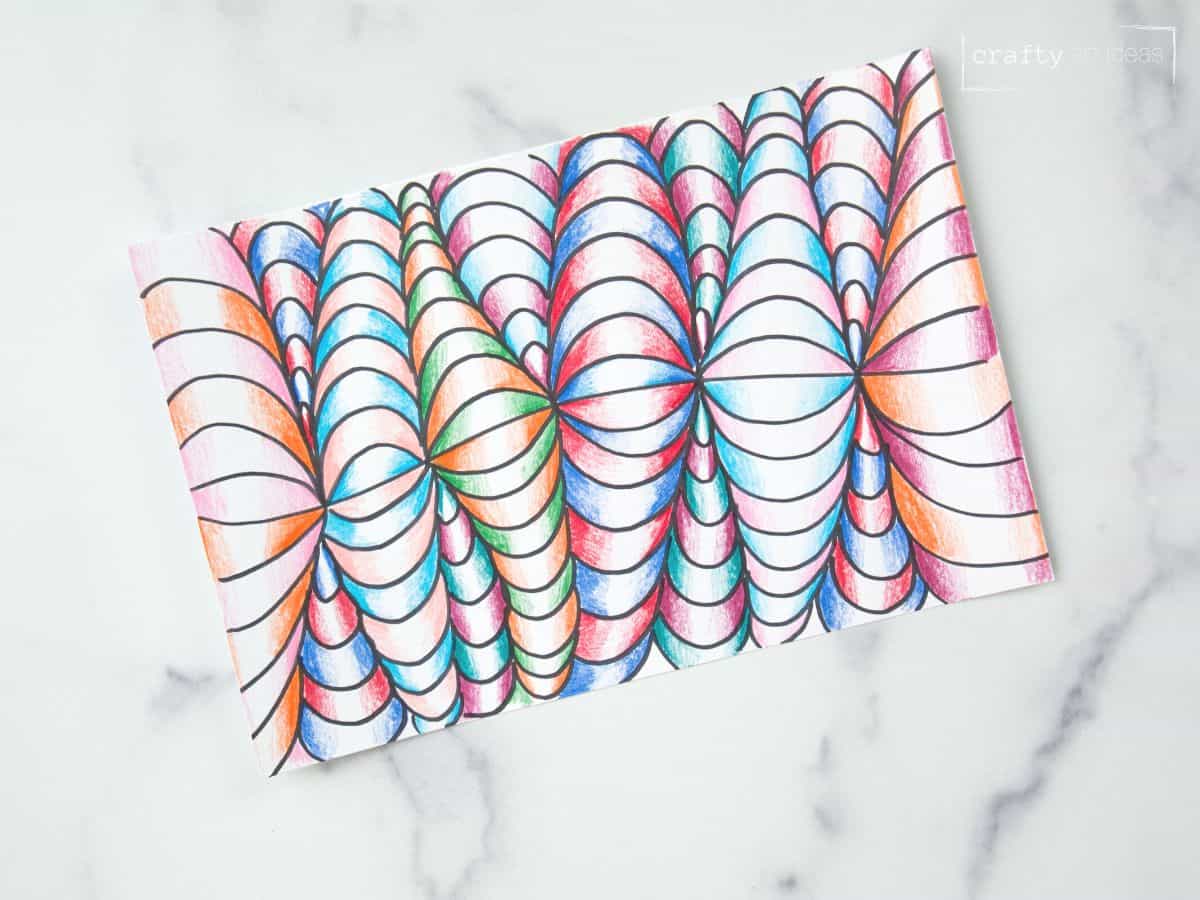
Disclosure: We only recommend products we would use ourselves and all opinions expressed are our own. This post may contain affiliate links when clicked, we may earn a small commission at no additional cost to you. Read our full privacy policy.
What age is this project for?
We normally completed this with 3rd graders. You will be amazed at some of the results you can get. However, some students that age did lack the abilities or fine motor skills.
Therefore, 4th grade and higher would probably be the best age to do this op drawing.
How To Explain Op Art To Kids
Have them guess what they think “Op” stands for. They are aware of optical illusions and understand that artists made art around this concept.
Check out this other simple Op Art tutorial for another Op Art lesson.
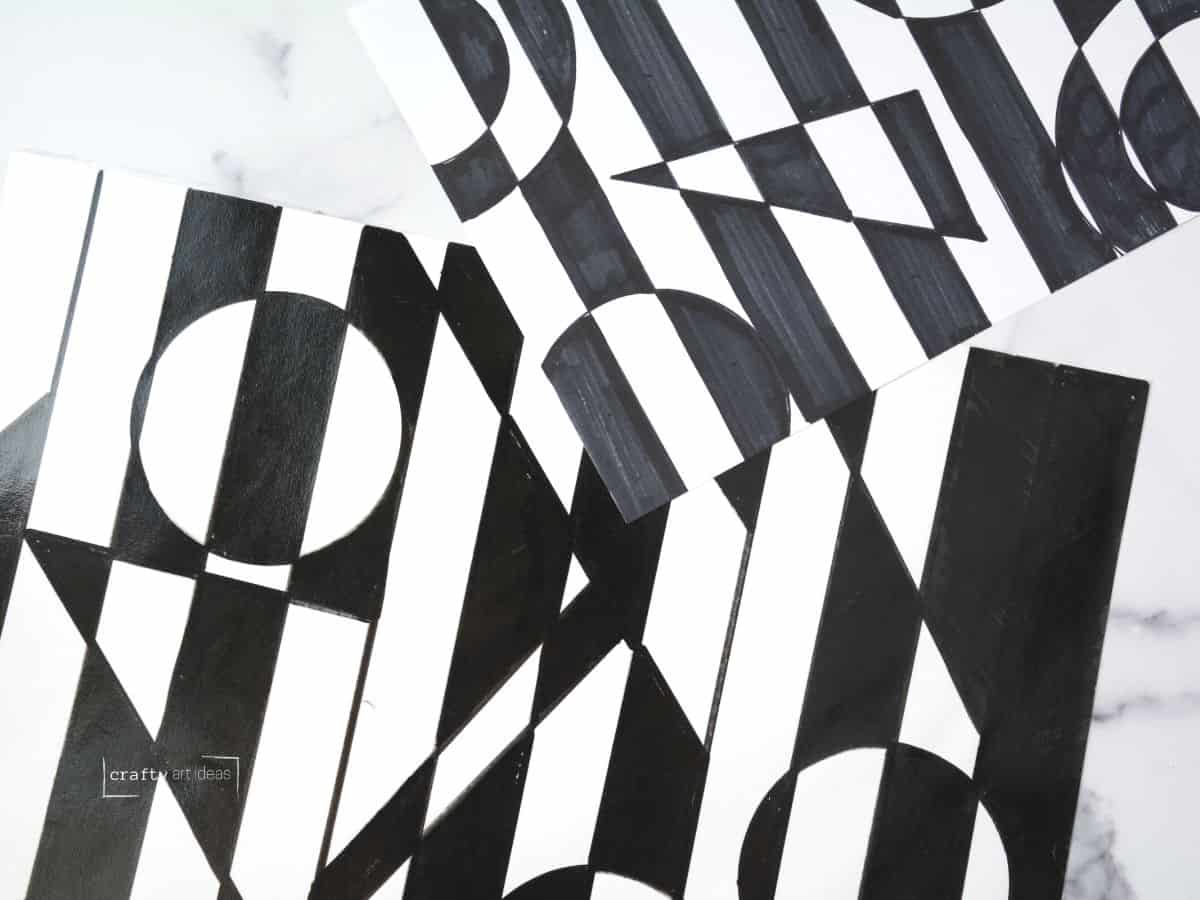
Understand Art Movement For Kids
This is a great time to help explain what an art movement is.
We liked to explain to kids that it would be like 4 of them realized they were all making art with the same style and ideas in the 1960s.
Artist Inspiration
- Bridget Riley: is best known for her black-and-white images that appear to move or blur together. Our favorite artwork of Riley’s is Cataract 3 painted in 1967.
- Victor Vasarely: is known to be the father of the Op Art movement. He uses more geometric shapes and color in his work to great confusion with depth. Vega 222, painted 1969-1970 and his other sphere artworks are some of our favorites.
Analyzing and Discussing
Look at a variety of artworks from the Op art movement. Use some of the following questions to get a discussion going with children.
- What colors do you see? Why do you think some are only black and white?
- How does the artist challenge your eye?
- If something is repeated, what happens to the shapes or sizes?
- Why would they use patterns?
- How does this artwork make you feel?
Note: You can also use similar questions and prompts when looking at other abstract artists like Kandinsky or Mondrian with children.

Recommend Supplies
- 6″ x 9″ Heavy White Drawing Paper
- Pencil
- Eraser
- Black Permanent Markers (ultra fine tip or regular fine tip)
- Colored Pencils
Always sketch light until you get it right!
Erin from Crafty Art Ideas
Note about the paper direction: These drawings work best if the paper is horizontal, but we have had a few where the child does really well with vertical paper.
How To Draw Op Art Design
Step 1: Draw A Line Near The Middle Of Your Page
This line can be straight or slightly wavy. It is important to not make it too wavy.
Step 2: Lightly Draw 5-7 Dots Across The Line
Try to make the dot evenly spaced. To do this start in the middle and add them out to the edge.

Step 3: Connect The Dots With A Rainbow Line
We also refer to this as a frown or smile line depending on which way you are holding the paper.
Step 4: Flip Paper Over and Repeat
Your drawing will look like a shell necklace going across the page.
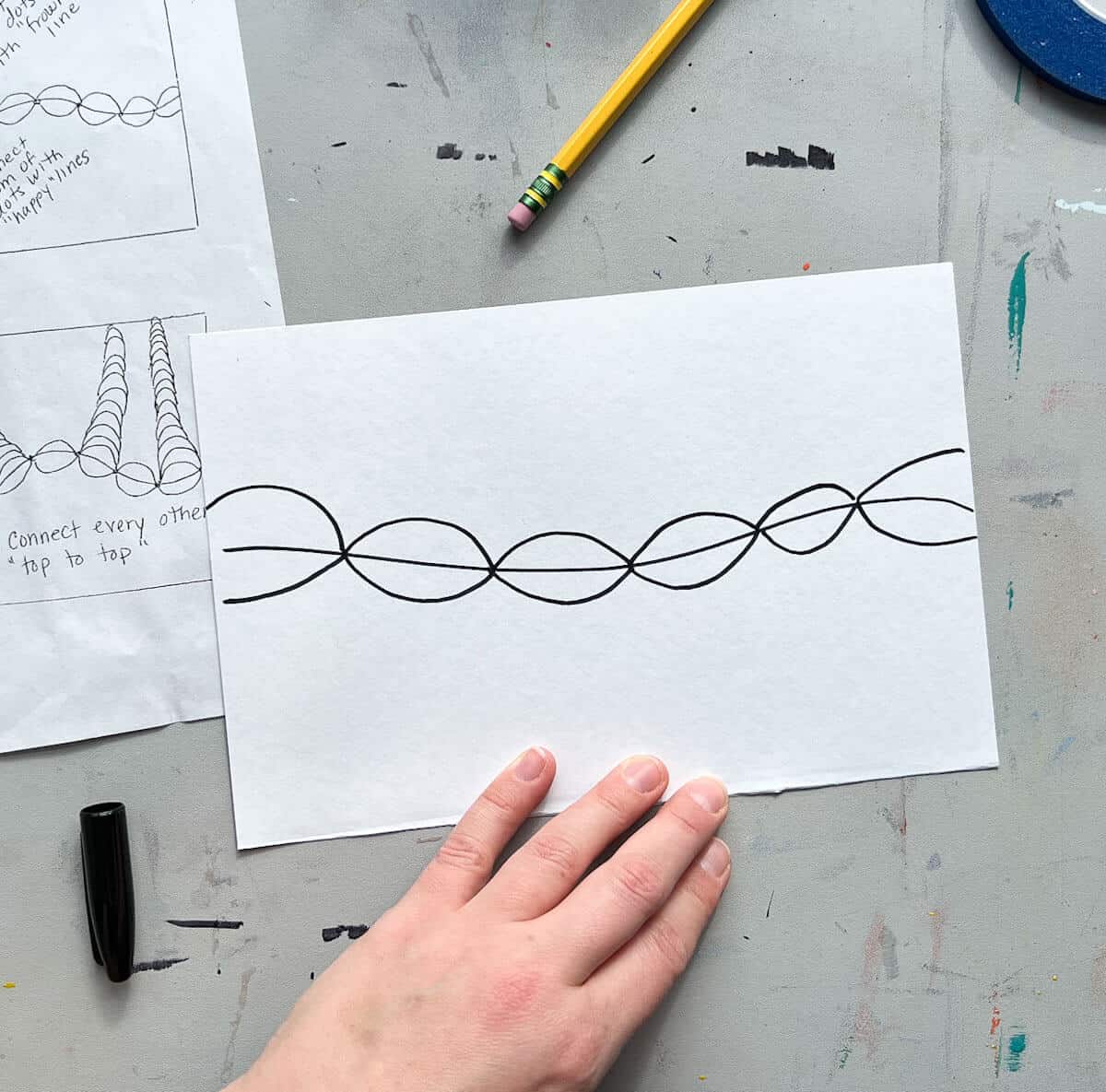
Step 5: Work On One Section And Repeatedly Draw Rainbow Lines
Working “top to top” draw curved lines until that row goes off the page. The lines will continue to get smaller and smaller.
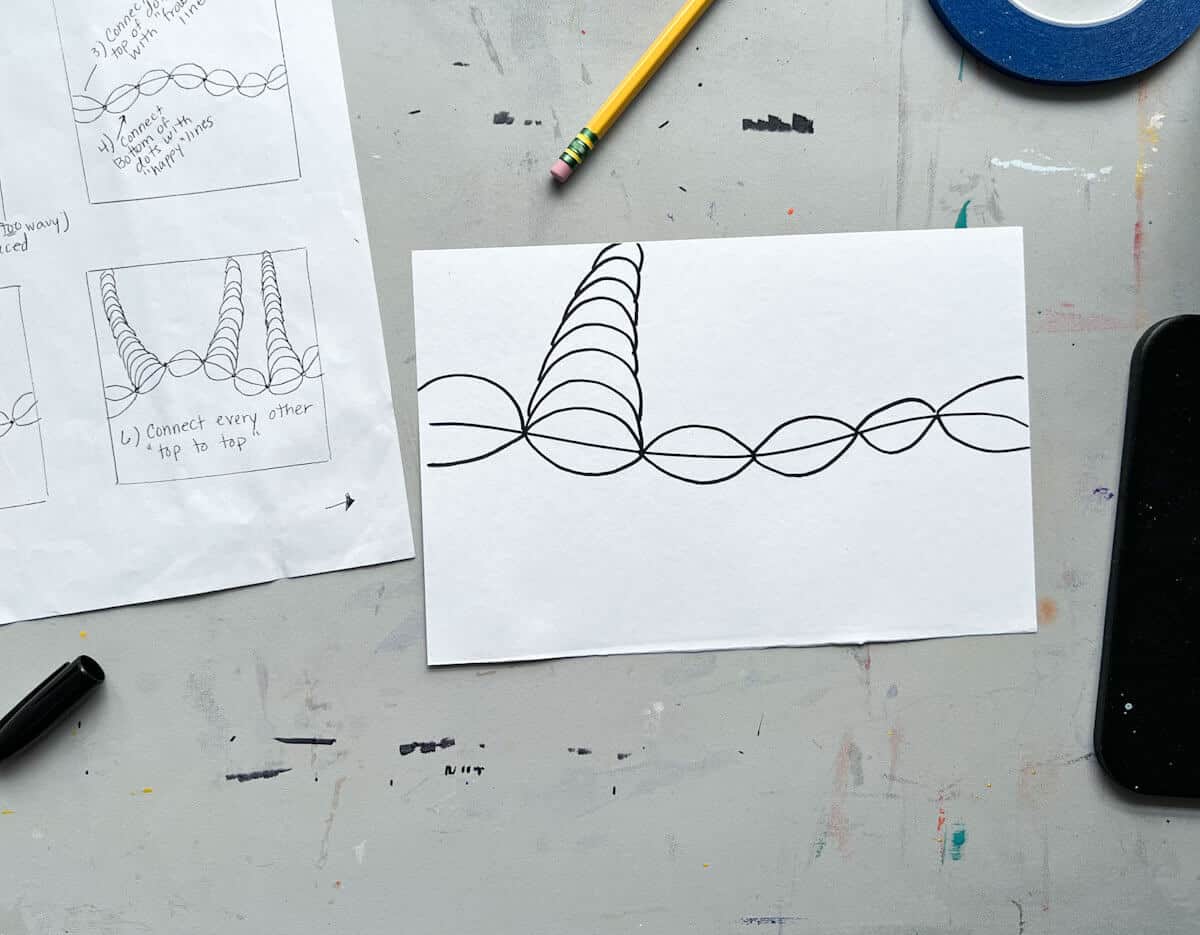
Step 6: Skip A “Shell” and Draw Repeat Drawing The Row
Repeat drawing top to top until you go off the page.

Step 7: Go Back And Work On Skipped Curve Lines
Repeat drawing curved lines. Some of your rows or “worms” may collide with the other drawings and lines. That is natural and part of the drawing.

Step 8: Flip The Paper Over And Repeat Steps 5-7
Work on every other shell to add the curved lines until you go off the page.

Step 9: Add Tear Drops In Empty Spaces If Needed
If you have an empty white space between wiggly lines, draw a teardrop shape and then curved lines until you go off the page.

If you drew in pencil (like we recommend) outline with a black marker when finished. Erase extra pencil lines before moving on to colored pencils.
This drawing is best if you outline it with a regular fine-tip sharpie. If lines are too small, then use an ultra-fine tip marker.
Read More: If you like this simple drawing tutorial you will also love how to create an easy mandala art lesson.
Shading With Colored Pencils
Step 1: Shade With Colored Pencils In The Edge
You will use the same color, across the band. On the edges, you want a darker value. Press harder and fade so that the middle is very light or white. Repeat on the other corner.

Experiment with the direction you color in. Some beginners find it easier to color vertically while others prefer horizontally. Pick the one that works best for you.
Step 2: Color In A Pattern
Repeat the darker corners with the same color in every other band. Use shading to create darker values in the corners with a different color.

Step 3: Repeat The Pattern Shading Process In Each Line

Step 4: Continue To Color All Rows
Color each row with different patterns. You can use the same two colors or switch your pattern design.
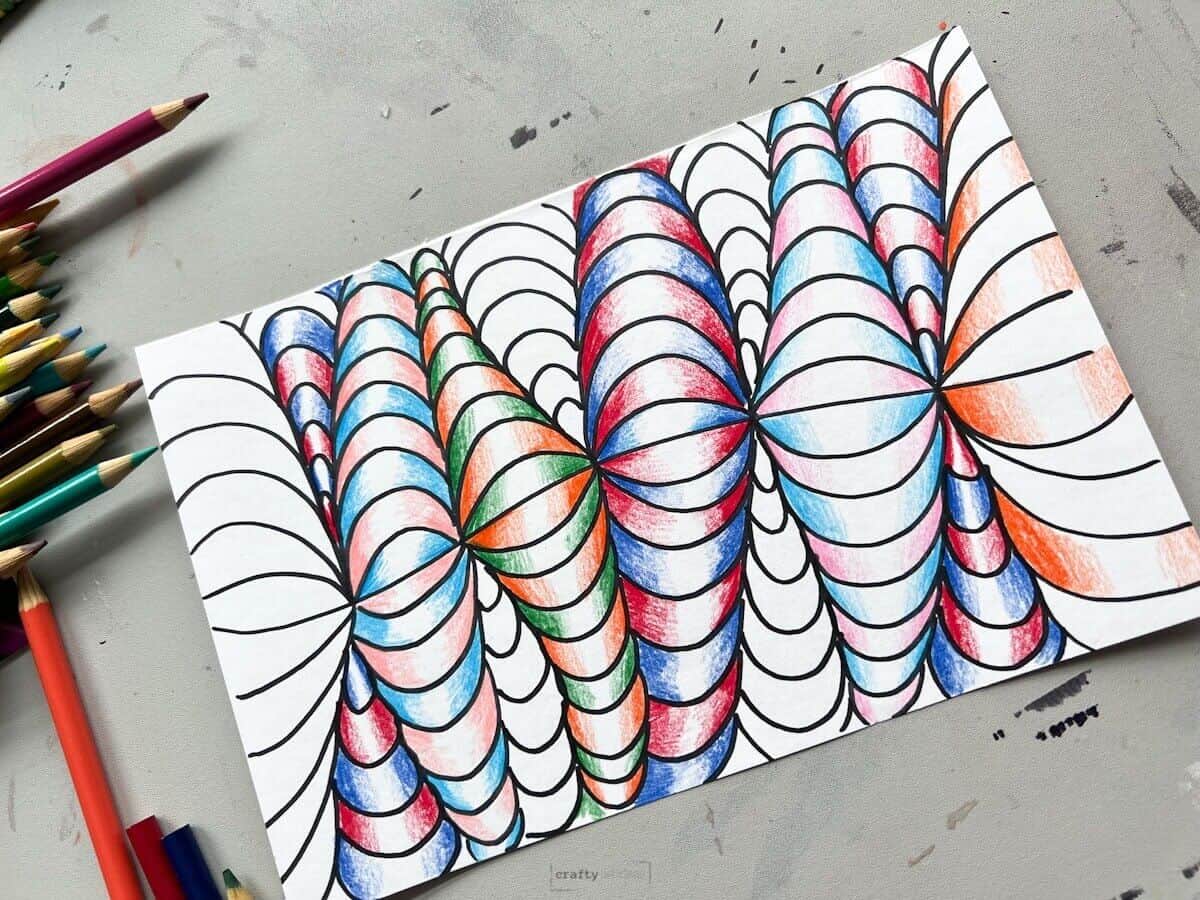
Op Art Drawing Tips
- Each row should be the same pattern. 2 colors work best, but you can use more than that as long you color in a pattern.
- You can use the same 2 or 3 colors for all the worms. Or switch for each row.
- Don’t draw more than 5-7 dots across your page. Your design will become too complicated for a 6″ x 9″ paper.
- It is fun if the “worms or wiggly lines” turn and twist. Encourage kids to have a variety. Just make sure that they overlap properly and don’t draw through each line.
- Draw with a pencil first, trace with a marker and then use a large eraser to get rid of pencil lines before coloring.
Follow us on Pinterest or Flipboard for more free art and craft ideas!
Tutorial FAQs
These drawings will take several class periods to complete. If you make them too large, children may become discouraged before they finish.
Yes, art lessons don’t just come out of a creative vacuum. Over the years, the directions above are how we best found to explain to 3rd graders and above. This is a lesson my father (a high school art teacher from the 80s) has been doing forever.
We show a few different steps in the drawing process to help create the wiggly lines or worms.
It is best to encourage the lines in the drawings not to go too close together. You may need to use a combination of markers depending on the shapes you end up with.
Related Drawing Ideas
- How To Draw Radial Symmetry For Beginners
- 9+ Mandala Art Ideas For Beginners
- Fun Laurel Burch Cat Art Lesson
- How To Draw A Simple Snowflake
Do you like this art project? Please give us 5 stars below 🤩🤩🤩🤩🤩 and have fun being creative with your family.
Easy Op Art Drawing For Kids

Equipment
- 1 Pencil
Supplies
- 1 Regular Fine Tip Black Permanent Marker
- 1 piece 6" x 9" White Drawing Paper
- Colored Pencils
Instructions
- Draw one straight or slightly wavy line across the page.
- Lightly draw 5-7 dots across your line. Try to make them evenly spaced.
- Connect the dots with curved lines on both sides. It will look like a shell necklace going across your page.
- On one section repeatedly draw curved lines connecting top to top. Working "top to top" draw curved lines until that row goes off the page. The lines will continue to get smaller and smaller.
- Repeat drawing curved lines on top of each section. Some of your rows or "worms" may collide with the other drawings and lines. That is natural and part of the drawing.
- Flip the paper over and repeat the previous three steps.
- If you have an empty white space between wiggly lines, draw a teardrop shape and then curved lines until you go off the page.
- If you drew in pencil (like we recommend) outline with a black marker when finished. Erase extra pencil lines before moving on to colored pencils.
Adding Colored Pencils
- Use the same color, across the band. On the edges, you want a darker value. Press harder and fade so that the middle is very light or white. Repeat on the other corner.
- Inside each long wiggly line, alternate two different colors and continue shading each shape.
- Use the same colors or different color combinations in each "wiggly line" to complete the project.
Notes
- Each row should be the same pattern. 2 colors work best, but you can use more than that as long you color in a pattern.
- You can use the same 2 or 3 colors for all the worms/wiggly lines. Or switch for each row.
- Don’t draw more than 5-7 dots across your page. Your design will become too complicated for a 6″ x 9″ paper.
- It is fun if the “worms or wiggly lines” turn and twist. Encourage kids to have a variety. Just make sure that they overlap properly and don’t draw through each line.
- Draw with a pencil first, trace with a marker and then use a large eraser to get rid of pencil lines before coloring.

